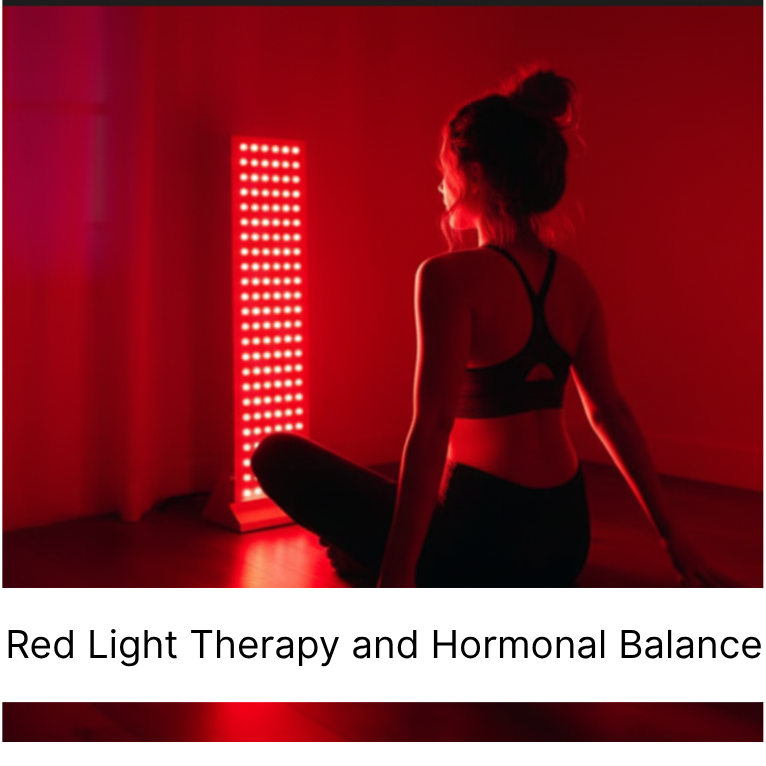Red Light Therapy and Hormonal Balance for Women

Hormonal balance plays a vital role in how women feel — influencing everything from energy levels and mood to skin health and sleep quality. Yet, many women experience fluctuations, especially during PMS or menopause, that can leave them feeling physically and emotionally drained.
In recent years, red light therapy has gained attention not just for its skin and anti-aging benefits but also for its potential to support hormonal balance. By gently affecting the body’s natural rhythms and biological processes, this therapy may help ease symptoms related to hormonal changes such as fatigue, irritability, and disrupted sleep.
Let’s explore how red light therapy interacts with hormones, and whether it can truly make a difference during PMS and menopause.
Connection Between Light and Hormones (Circadian Rhythm)
Light has a profound influence on our body’s internal clock, known as the circadian rhythm. This 24-hour cycle governs sleep, wakefulness, metabolism, and hormone secretion. Natural sunlight, especially in the morning, signals the brain to regulate the production of key hormones such as cortisol, serotonin, and melatonin.
When light exposure becomes inconsistent — as often happens with long work hours indoors or during the darker months — the circadian rhythm can become disrupted. This imbalance can lead to sleep problems, mood swings, and irregular hormonal patterns.
Red light therapy helps mimic aspects of natural light, promoting alignment of the circadian rhythm and supporting better hormonal regulation. Unlike blue or white light, which can be stimulating, red light has a calming and restorative effect, encouraging balance rather than disruption.
How Red Light May Influence Estrogen and Melatonin
Red light therapy works by stimulating mitochondria, the “powerhouses” of our cells, which increases energy production and cellular repair. But beyond skin deep, this process may also affect hormone-related functions.
Research suggests that exposure to red and near-infrared wavelengths may influence the production of melatonin — the hormone that regulates sleep — by supporting the body’s natural light-dark cycle. Better sleep quality alone can have a significant impact on hormone stability, particularly during PMS or menopause when insomnia is common.
Some studies also indicate that red light therapy may indirectly support estrogen balance by improving cellular health in the ovaries and adrenal glands, both of which are involved in hormone production. While more research is needed, early findings point toward a positive connection between red light therapy and overall hormonal health.
Studies on Light Exposure and Menopause Symptoms
Scientific studies exploring light exposure and menopause have shown encouraging results. Women exposed to specific light wavelengths, including red and near-infrared, reported reduced hot flashes, improved mood, and better sleep quality.
In a clinical trial, participants who used light therapy regularly experienced fewer vasomotor symptoms — such as night sweats and sudden warmth — and an increase in overall well-being. This improvement may be linked to red light’s ability to enhance circulation, reduce inflammation, and regulate sleep hormones.
While most of these studies are still in the early stages, they offer promising insight into how controlled light exposure can support women through hormonal transitions with fewer discomforts and a greater sense of balance.
Using Red Light for Mood Swings, Fatigue, and Sleep
Hormonal fluctuations during PMS and menopause can cause mood changes, low energy, and restless nights. Red light therapy may offer a natural, non-invasive way to restore calm and vitality.
When used in the evening, red light helps stimulate melatonin production, promoting deeper, more restful sleep. Better sleep, in turn, helps stabilize mood and reduces fatigue. The gentle light also influences serotonin levels — the “feel-good” hormone — which may explain the sense of relaxation many users experience after sessions.
Regular exposure to red light can also boost cellular energy and circulation, helping the body combat the exhaustion and mental fog often associated with hormonal imbalance. By supporting emotional balance and physical well-being, it can become a grounding ritual during times of change.
Safety and Limitations
Red light therapy is widely considered safe when used correctly. It’s non-invasive, painless, and free from UV rays, making it suitable for at-home or professional use.
However, it’s essential to recognize that red light therapy is not a replacement for medical treatment. It is a complementary approach to support overall hormonal health, alongside lifestyle habits like balanced nutrition, regular exercise, and stress management.
Women with specific medical conditions, such as thyroid disorders or photosensitivity, should consult a healthcare professional before starting light therapy. Moderation and consistency yield the best results — not excessive exposure.
Finding Balance and Calm Through Red Light Therapy
Red light therapy offers a gentle, science-backed way to support hormonal balance and ease some of the challenges women face during PMS and menopause. By harmonizing the body’s natural rhythms, improving sleep, and enhancing mood, it helps restore a sense of stability from within.
While not a cure-all, it stands out as a comforting and effective addition to a holistic wellness routine. In a world where stress and imbalance are all too common, red light therapy serves as a reminder that sometimes, the softest light can bring the deepest calm — illuminating the path to harmony and well-being.
